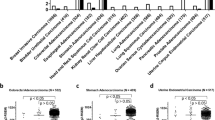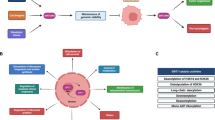Abstract
We have identified a novel human septin family gene Bradeion, which is specifically expressed in human colorectal cancer and malignant melanoma. In order to analyze the implications of tumor-specific gene expression, ribozymes and its derivatives were specifically designed and transfected into various colorectal adenocarcinoma cell lines for Bradeion inactivation. We constructed ribozyme expression plasmids controlled by a human tRNAVal promoter, and both hammerhead ribozyme and its allosteric derivative maxizyme were used for two different forms of Bradeion mRNA. The sequence-specific cleavage of Bradeion mRNA resulted in significant growth inhibition and G2 arrest in human cancer cell lines, detected by flow cytometry analysis. In addition, in vivo mice studies demonstrated marked tumor growth suppression by the Bradeion-specific ribozymes. Thus, the tumor-specific and selective marker Bradeion also provides valuable tools as a potential target for colorectal cancer therapy.
This is a preview of subscription content, access via your institution
Access options
Subscribe to this journal
Receive 12 print issues and online access
$259.00 per year
only $21.58 per issue
Buy this article
- Purchase on Springer Link
- Instant access to full article PDF
Prices may be subject to local taxes which are calculated during checkout



Similar content being viewed by others
References
Tanaka M, Tanaka T, Kijima H et al. Characterization of tissue- and cell type–specific expression of a novel human septin family gene Bradeion Biochem Biophys Res Commun 2001 286: 547–553
Vile RG, Diaz RM . Gene therapy In: Spurr NK, Young BD, Bryant SP, eds ICRF Handbook of Genome Analysis Oxford: Blackwell 1998 649–666
Bunz F, Dutriaux A, Lengauer C et al. Requirement for p53 and p21 to sustain G2 arrest after DNA damage Science 1998 282: 1497–1501
Tanaka M, Tanaka T, Harata M, Suzuki T, Mitsui Y . Triplet repeat-containing ribosomal protein L14 gene in immortalized human endothelial cell line (t-HUE4) Biochem Biophys Res Commun 1998 243: 531–537
Longtine MS, DeMarini DJ, Valencik ML et al. The septins: roles in cytokinesis and other processes Curr Opin Cell Biol 1996 8: 106–119
Wood JN, Hudson L, Jessell TM et al. A monoclonal antibody defining antigenic determinants on subpopulations of mammalian neurones and Typanosoma cruzi parasites Nature 1982 296: 34–38
Kijima H, Ishida H, Ohkawa T et al. Therapeutic applications of ribozymes Pharmacol Ther 1995 68: 247–267
Yamazaki H, Kijima H, Ohnishi Y et al. Inhibition of tumor growth by ribozyme-mediated suppression of aberrant epidermal growth factor receptor gene expression J Natl Cancer Inst 1998 90: 581–587
Tsuchida T, Kijima H, Hori S et al. Adenovirus-mediated anti–K-ras ribozyme induces apoptosis and growth suppression of human pancreatic carcinoma Cancer Gene Ther 2000 7: 373–838
Kawasaki K, Eckner R, Yao TS et al. Distinct roles of the co-activators p300 and CBP in retinoic-acid–induced F9-cell differentiation Nature 1998 393: 284–289
Kuwabata T, Warashina M, Nakayama A et al. tRNAVal-heterodimeric maxizymes with high potential as gene inactivating agents: simultaneous cleavage at two sites in HIV-1 Tat mRNA in cultured cells Proc Natl Acad Sci USA 1999 95: 1886–1891
Leibovitz A, Stinson JC, McCombs Wb III et al. Classification of human colorectal adenocarcinoma cell lines Cancer Res 1976 36: 4562–4569
Walker JE, Saraste M, Runswick MJ et al. Distantly related sequences in the alpha- and β-subunits of ATP synthase, myosin, kinases and other ATP-requiring enzymes and a common nucleotide binding fold EMBO J 1982 1: 945–951
Saraste M, Sibbald PR, Wittinghoger A . The P-loop — a common motif in ATP- and GTP-binding proteins Trends Biochem Sci 1990 15: 430–434
Capon DJ, Seeburg PH, McGrath JP et al. Activation of Ki-ras2 gene in human colon and lung carcinomas by two different point mutations Nature 1983 304: 507–513
Barbacid M . ras gene Annu Rev Biochem 1987 56: 779–827
Bos JL . Prevalence of ras gene mutations in human colorectal cancers Cancer Res 1989 49: 4682–4689
Larisch S, Yi Y, Lotan R et al. A novel mitochondrial septin-like protein, ARTS, mediates apoptosis dependent on its P-loop motif Nat Cell Biol 2000 2: 915–921
Acknowledgements
The authors thank Akira Togiya (Takara Shuzo, Tokyo) for sequence service; Wu-Bo Li (Life Technologies, Rockville, MD), S Hadano and J-E Ikeda (Tokai University), H Kawasaki (Tokyo University), and Y Nagasaka (Beckman Instruments) for valuable discussions and technical advice; and Kenji Sekikawa (National Institute of Agrobiological Sciences) for critical reading of the manuscript.
Author information
Authors and Affiliations
Corresponding author
Rights and permissions
About this article
Cite this article
Tanaka, M., Kijima, H., Itoh, J. et al. Impaired expression of a human septin family gene Bradeion inhibits the growth and tumorigenesis of colorectal cancer in vitro and in vivo. Cancer Gene Ther 9, 483–488 (2002). https://doi.org/10.1038/sj.cgt.7700460
Received:
Published:
Issue Date:
DOI: https://doi.org/10.1038/sj.cgt.7700460
Keywords
This article is cited by
-
Linking the septin expression with carcinogenesis
Molecular Biology Reports (2010)
-
Do septins have a role in cancer?
British Journal of Cancer (2005)
-
In vitro monitoring of GTPase activity and enzyme kinetics studies using capillary electrophoresis
Analytical and Bioanalytical Chemistry (2005)



